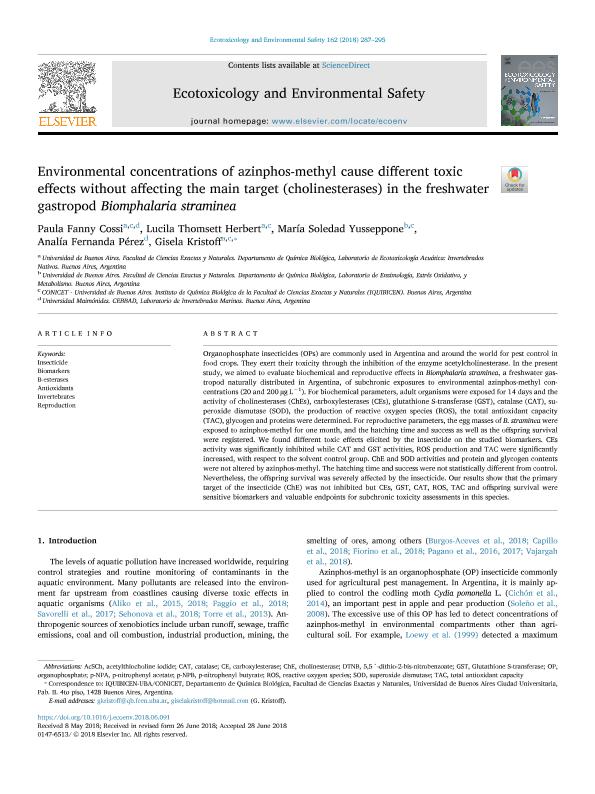Artículo
Environmental concentrations of azinphos-methyl cause different toxic effects without affecting the main target (cholinesterases) in the freshwater gastropod Biomphalaria straminea
Cossi, Paula Fanny ; Herbert, Lucila Thomsett
; Herbert, Lucila Thomsett ; Yusseppone, Maria Soledad
; Yusseppone, Maria Soledad ; Pérez, Analía Fernanda
; Pérez, Analía Fernanda ; Kristoff, Gisela
; Kristoff, Gisela
 ; Herbert, Lucila Thomsett
; Herbert, Lucila Thomsett ; Yusseppone, Maria Soledad
; Yusseppone, Maria Soledad ; Pérez, Analía Fernanda
; Pérez, Analía Fernanda ; Kristoff, Gisela
; Kristoff, Gisela
Fecha de publicación:
10/2018
Editorial:
Academic Press Inc Elsevier Science
Revista:
Ecotoxicology and Environmental Safety
ISSN:
0147-6513
Idioma:
Inglés
Tipo de recurso:
Artículo publicado
Clasificación temática:
Resumen
Organophosphate insecticides (OPs) are commonly used in Argentina and around the world for pest control in food crops. They exert their toxicity through the inhibition of the enzyme acetylcholinesterase. In the present study, we aimed to evaluate biochemical and reproductive effects in Biomphalaria straminea, a freshwater gastropod naturally distributed in Argentina, of subchronic exposures to environmental azinphos-methyl concentrations (20 and 200 µg L−1). For biochemical parameters, adult organisms were exposed for 14 days and the activity of cholinesterases (ChEs), carboxylesterases (CEs), glutathione S-transferase (GST), catalase (CAT), superoxide dismutase (SOD), the production of reactive oxygen species (ROS), the total antioxidant capacity (TAC), glycogen and proteins were determined. For reproductive parameters, the egg masses of B. straminea were exposed to azinphos-methyl for one month, and the hatching time and success as well as the offspring survival were registered. We found different toxic effects elicited by the insecticide on the studied biomarkers. CEs activity was significantly inhibited while CAT and GST activities, ROS production and TAC were significantly increased, with respect to the solvent control group. ChE and SOD activities and protein and glycogen contents were not altered by azinphos-methyl. The hatching time and success were not statistically different from control. Nevertheless, the offspring survival was severely affected by the insecticide. Our results show that the primary target of the insecticide (ChE) was not inhibited but CEs, GST, CAT, ROS, TAC and offspring survival were sensitive biomarkers and valuable endpoints for subchronic toxicity assessments in this species.
Palabras clave:
insecticide
,
antioxidants
,
invertebrates
,
reproduction
,
biomarkers
,
B-esterases
Archivos asociados
Licencia
Identificadores
Colecciones
Articulos(IIMYC)
Articulos de INSTITUTO DE INVESTIGACIONES MARINAS Y COSTERAS
Articulos de INSTITUTO DE INVESTIGACIONES MARINAS Y COSTERAS
Articulos(IQUIBICEN)
Articulos de INSTITUTO DE QUIMICA BIOLOGICA DE LA FACULTAD DE CS. EXACTAS Y NATURALES
Articulos de INSTITUTO DE QUIMICA BIOLOGICA DE LA FACULTAD DE CS. EXACTAS Y NATURALES
Articulos(SEDE CENTRAL)
Articulos de SEDE CENTRAL
Articulos de SEDE CENTRAL
Citación
Cossi, Paula Fanny; Herbert, Lucila Thomsett; Yusseppone, Maria Soledad; Pérez, Analía Fernanda; Kristoff, Gisela; Environmental concentrations of azinphos-methyl cause different toxic effects without affecting the main target (cholinesterases) in the freshwater gastropod Biomphalaria straminea; Academic Press Inc Elsevier Science; Ecotoxicology and Environmental Safety; 162; 10-2018; 287-295
Compartir
Altmétricas



